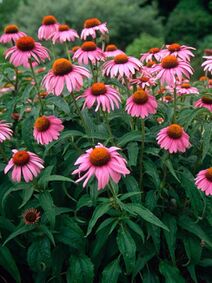Echinacea purpurea
| Echinacea purpurea | |
 | |
| Light: | |
| Moisture: | |
| Hardiness: | 3 |
| Soil pH: | 5.6-8.4 |
| Height: | 4' |
| Width: | 2' |
| Blooms: | Mid Summer-Late Summer |
| Native to: | |
| Nectary | |
| Edible Rating: | |
| Medicinal Rating: | |
| Tea: | Yes |
Echinacea purpurea (common names: echinacea and purple coneflower)
Many showy coneflower varieties vie for attention, but wilt when compared to this flower with its high-quality nectar and open-pollinated seeds. Bees, hummingbirds, and monarch butterflies once fed upon this abundant nectar source in prairies and fields before they were developed into parking lots. Fortunately, this easy-to-grow and deer-resistant flower is prized for prairie restorations and sought by gardeners. This moderate-grower needs more than one season to bloom to its fullest, but is worth the wait for its striking sweet-fragranced lavender-pink blossoms perched upon purple-streaked steams. The flowers of this drought tolerant plant make excellent cuttings and promote new buds when picked which extend the blooming season. Let remaining blossoms turn to seed in Autumn for birds, particularly finches, to feast upon and propagate in surrounding areas. Avoid fertilizers which create leggy stems that are unable to support the blossom’s weight.
Propagation: Seed - sow March/April in a greenhouse and only just cover the seed[1][K]. Diurnal temperature fluctuations aid germination[1]. The seed usually germinates in 10 - 21 days at 25°c[1]. Prick out the seedlings into individual pots once they are large enough to handle and grow them on in the greenhouse for the first summer. Plant them out in the late spring or early summer of the following year and give them some protection from slugs at least until they are established[K].
Division in spring or autumn[2]. Larger clumps can be replanted direct into their permanent positions, though it is best to pot up smaller clumps and grow them on in a cold frame until they are rooting well. Plant them out in the spring.
Root cuttings, October in a frame[3].
Cultivation: Prefers a deep rich loam with plenty of leafmold[4] and a sunny position[1]. Succeeds in dry soils and tolerates drought once it is established[5]. Prefers a good light soil[6].
A very ornamental plant, there are some named varieties[6].
Slugs love this plant[K].
Range: N. America - Virginia to Ohio and Michigan, south to Georgia and Louisiana.
Habitat: Dry open woods, prairies and barrens[7].
Edibility: Leaves[5]. No more details are given.
Medicinal: Echinacea is considered to be the most effective detoxicant in Western herbal medicine for the circulatory, lymphatic and respiratory systems[8][9]. Its use has also been adopted by Ayurvedic medicine[8].
Plants in this genus were probably the most frequently used of N. American Indian herbal remedies. They had a very wide range of applications and many of these uses have been confirmed by modern science. This species is the most easily cultivated of the genus and so has been more generally adopted for its medicinal uses[8]. The plant has a general stimulatory effect on the immune system and is widely used in modern herbal treatments[10]. In Germany over 200 pharmaceutical preparations are made from Echinacea[10].
There has been some doubt over the ability of the body to absorb the medicinally active ingredients orally (intravenous injections being considered the only effective way to administer the plant), but recent research has demonstrated significant absorption from orally administered applications[10]. The roots and the whole plant are considered particularly beneficial in the treatment of sores, wounds, burns etc, possessing cortisone-like and antibacterial activity[10]. The plant was used by N. American Indians as a universal application to treat the bites and stings of all types of insects[11]. An infusion of the plant was also used to treat snakebites[11].
The root is adaptogen, alterative, antiseptic, aphrodisiac, depurative, diaphoretic, digestive, sialagogue[12][13][14][5][15][11]. It is harvested in the autumn and dried for later use[8].
Pollinators: Insects
Soil: Can grow in light and medium soils.
Drainage: Prefers well drained soil.
Flower Type: Hermaphrodite
Links
- Echinacea purpurea - Plants for a Future
- Echinacea purpurea - United States Department of Agriculture Plants Profile
References
- ↑ 1.0 1.1 1.2 1.3 Bird, Alfred. Focus on Plants Volume 5. Thompson and Morgan, 1991.
- ↑ Sanders, Thomas. Popular Hardy Perennials. Collingridge, 1926.
- ↑ Huxley, Anthony. The New Royal Horticultural Society Dictionary of Gardening. MacMillan Press, 1992.
- ↑ Chittendon, Fred. RHS Dictionary of Plants. Oxford University Press, 1951.
- ↑ 5.0 5.1 5.2 Natural Food Institute. Wonder Crops 1987.
- ↑ 6.0 6.1 Phillips, Roger and Martyn Rix. Perennials - The Definitve Reference. Pan Books, 1991.
- ↑ Lyndon, Merritt. Gray's Manual of Botany. American Book Co, 1950.
- ↑ 8.0 8.1 8.2 8.3 Bown, Deni. Royal Horticultural Society Encyclopaedia of Herbs and Their Uses. Dorling Kindersley, 1995.
- ↑ Chevallier, Andrew. The Encyclopedia of Medicinal Plants. Dorling Kindersley, 1996.
- ↑ 10.0 10.1 10.2 10.3 Foster, Steven and Billy Tatum. Medicinal Plants of Eastern and Central North America. Houghton Mifflin, 1990.
- ↑ 11.0 11.1 11.2 Weiner, Michael. Earth Medicine, Earth Food. Ballantine Books, 1980.
- ↑ Grieve, Margaret. A Modern Herbal. Penguin, 1984.
- ↑ Lust, John. The Herb Book. Bantam Books, 1983.
- ↑ Usher, George. A Dictionary of Plants Used by Man. Constable, 1974.
- ↑ Mills, Simon. The Dictionary of Modern Herbalism.